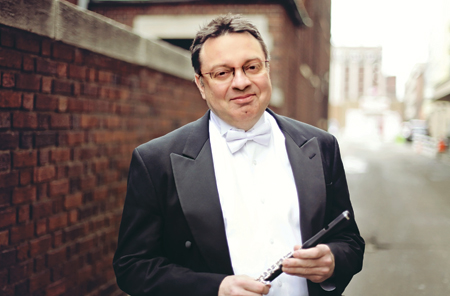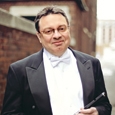
This year Jeffery Zook celebrates his 25th season as piccoloist with the Detroit Symphony. Currently on the faculty of Oakland University, Zook is a graduate of the Interlochen Arts Academy, University of Michigan, and Royal Academy of Music. This summer he and DSO flutist Sharon Sparrow premiered Telemann for Two!, which is the adaptation of the solo Fantasias for two flutes, at the National Flute Association Convention.
Where do you place your cork?
For my Burkart piccolo, the mark on the cleaning rod is in the center of the embouchure hole. For my 1970 Powell piccolo, however, I push the cork in a tiny bit. This helps the top register notes sound a little higher.
How do you align the headjoint with the body?
The middle of the embouchure hole is centered with the first key.
How do you care for your wooden piccolo?
I use the piccolo flag obsessively. Sometimes I use almond oil on the headjoint.
Do you wear one or two ear plugs?
For extremely high and loud piccolo concerts I wear one ear plug. If it is a pops concert I might wear two. I also own a pair of hearing protection silencer headsets, like those used in the rifle range or on the ground at airports. These are great for practicing Shostakovich at home for extended periods of time. The hearing protection silencer headsets are also useful to help young flute students realize how much they can blow. If you play with them on for a few minutes, you will feel and hear a difference. Around my house, these are called my Princess Leia headphones.
What alternate fingerings do you use on a regular basis?
My all-time favorite is C#6: 0230|1004 (no left thumb) which corrects the flat pitch on most piccolos. Another one is touching the right-hand pinky over the end of the instrument while playing the top A. This trick works well for pp high A – as in Mahler’s Symphony No. 6
How do you warm up?
I just bought the Nicola Mazzanti piccolo book and have been using that lately. I find the singing and playing exercises improve my tone and set up for the day.
Do you have any tuning tricks when playing in an orchestra?
When playing tutti ff woodwind passages, the Eb clarinet can be quite flat. I usually resort to fingering everything down a twelfth (when possible) and overblowing at the third partial. This makes it loud and flat and is a nice compromise. The blend works better than trying to lip everything down.
What are your thoughts on vibrato when playing the piccolo vs. the flute.
As with most aspects of the piccolo, you need to use a lot less effort and motion than you do on the flute. If you use the same amplitude of vibrato in the 3rd octave of the piccolo as you do on the flute, the sound is going to be hysterical. Find a mechanism to create shimmer that involves the slightest of movement for fast vibrato (as in something melodic like Procession of the Sardar from Caucasian Sketches). The vibrato needs to be in the sound, not around it. Also, thinking of this mechanism when ascending into the higher octave helps to increase the air speed. Concentrate on the vibrato and the support, rather than the blowing, to create a free sound in the third octave without harshness.
What are the top five (or ten) excerpts a piccolo player should know well?
The Jack Wellbaum book Orchestral Excerpts for the Piccolo lists these the best. Because the piccolo is so prominent, I suggest studying and learning the difficult passages to all of the Shostakovich Symphonies. There is some really exposed soft playing in Symphony No. 11and some fast technical passages in Symphony No. 15 that I encourage students to learn and memorize for the challenges they create. This prepares them for when they appear in their music folder one day.
Which piccolo players have influenced your playing?
When I was in college, I remember hearing a concert of the Pittsburgh Symphony where Ethan Stang played Ravel’s Rhapsodie Espagnole. I will never forget the rich dark sound he produced. I had never heard anything like this before. It changed my idea of the piccolo sound completely.
After graduation I studied with Clement Barone, who was my predecessor in the Detroit Symphony. During his 35-year career with the Detroit Symphony, Barone recorded extensively. You can hear him on the Detroit Symphony Orchestra recordings with Paul Paray, but most amazing is his later recording Bacchus & Ariadne: Suite No. 2 by Albert Roussel under Neeme Järvi. Barone embodied the true bel canto style of playing – placing emphasis on lyricism and singing beauty in every note.
Nicola Mazzanti has come to Detroit several times in the past decade, and I have enjoyed watching him perform and teach. He is a huge inspiration and good friend. I am now exploring solo piccolo repertoire that I never knew existed, and my physical approach to the instrument has benefited from listening and observing him and playing for him.





